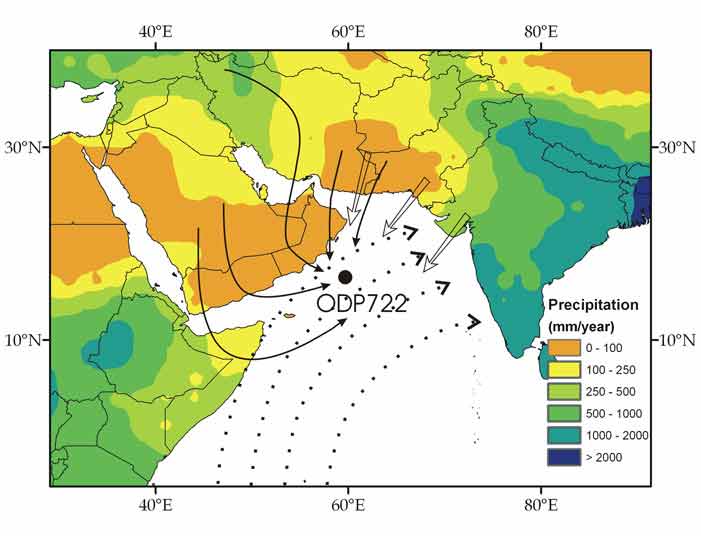
|
June 13, 2007 |
Paleoclimatology
Shifting Weather Patterns Drove Miocene Grassland Expansion
An 11 million year sediment record from the Arabian Sea provides evidence that changing weather patterns – rather than declining carbon dioxide levels – drove grassland expansion in the tropics and subtropics over the past 10 million years. Brown University geologists based their findings on variations in carbon and hydrogen isotope ratios from specific leaf wax compounds. | |||
|
Brown University Home |
PROVIDENCE, R.I. [Brown University] — It’s hard enough to know what happened in the distant past, but understanding why it happened requires some serious detective work. Between five and ten million years ago, grasslands began squeezing out forests and savannah across the tropics and subtropics, a change that may have driven the evolution of large grazing animals. What drove the botanical shift has been much less clear. By comparing several information sources, Brown University geologists have built a solid case that declining rainfall and shifting weather patterns were the primary culprits. A group of Brown University geologists, including Associate Professor Yongsong Huang, Associate Professor Steven Clemens, and Professor Warren Prell, as well as visiting scientist Weiguo Liu and postdoctoral researcher Yi Wang, sliced, diced, sorted, extracted, and analyzed the components of an Arabian Sea sediment core spanning 11 million years to get at the cause of the shift. One suspected cause was a large drop in the concentration of atmospheric carbon dioxide, which —if true— offered hope that Earth’s climate system might have a built-in way of eliminating excess carbon dioxide and combating global warming. However, Huang’s research suggests that changing precipitation is a more likely explanation. “Because of the importance of carbon cycling in affecting Earth’s climate patterns we really want to understand the natural fluctuations in atmospheric CO2,” said Huang. It would have been exciting to find evidence for a natural mechanism that could remove carbon dioxide from the air, but the evidence pointed to rainfall instead. “The results are, to me, really conclusive,” said Huang. The researchers chose this particular core from a seafloor ridge that receives a steady rain of dust blown off the Arabian Peninsula and the Himalayan foreland. Unlike soil samples or sediments influenced by river deposits, the core provided a single continuous record that could be dated through several corroborating methods. 
11 million years of weather Trees and tropical grasses use slightly different biochemical pathways to make biomass from sunlight and carbon dioxide, which results in a marked difference between the two groups in the ratio of 13C (a rare but stable isotope of carbon) to 12C (the most common isotope of carbon). Plant leaf waxes inherit such isotopic differences; hence leaf waxes preserved in sediments record past changes in the regional abundance of trees and tropical grasses. Each pathway also has certain ecological advantages. Most tropical grasses employ a pathway (called C4), which actively acquires and stores carbon dioxide for later use. The approach uses low levels of carbon dioxide more efficiently than the pathway used by trees and shrubs (called C3), which processes carbon dioxide as it is absorbed. C4 plants also conserve water and withstand heat better than C3 plants. Carbon isotopes alone reveal only the increased presence of C4 grasses from five to ten million years ago, but by comparing hydrogen isotopes from the same compounds, researchers can unravel the probable causes behind the change. The core revealed a record of changing plant abundances tied to water availability. Looking at leaf wax compounds found only in terrestrial plants, Huang and colleagues compared the way carbon and hydrogen isotopes varied through time. The researchers used carbon isotope ratios to track the proportion of grasses from about 25 percent at 10 million years ago through a decline to 15 percent and back up to about 65 percent five and a half million years ago – a pattern similar to what others have observed, but with much greater detail and larger scale. The steepest rise occurred between 7.9 and 5.5 million years ago. To get at the causes, Huang’s team also looked at hydrogen isotopes from the same leaf wax compounds. They found that proportions of the rare deuterium isotope rose dramatically, preceding slightly the rise in grass abundance, indicating that sources and amount of rainwater changed before the plant mix changed. A similar pattern was also reflected in oxygen isotopes from soil cores in the region – another proxy, albeit with more complications and less certainty, for plant water availability. Based on the isotopic patterns in modern precipitation, the increasing ratios of deuterium most likely reflect a reduction in summer monsoon intensity in the Arabian continent and Himalayan region since ten million years ago. A southward shift in monsoon circulation would also tend to decrease water availability in the growing season – further accentuating the hydrogen isotope shift. Editors: Brown University has a fiber link television studio available for domestic and international live and taped interviews and maintains an ISDN line for radio interviews. For more information, call the Office of Media Relations at (401) 863-2476. ###### | |||